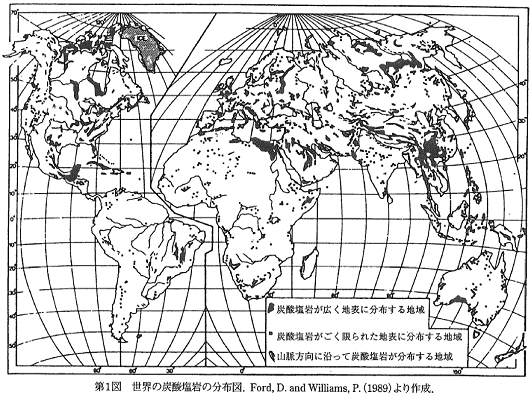 〔牧 雄一郎・松本仁之(2000):石灰石鉱業の現状と課題.地質ニュース、547号、23-35.【見る→】から〕 |
戻る<1|2|3|4|5|6|7|8|9|10|11|12|13|14|15<
|
|
| 配付プリント等 |
| 補足説明 |
|
|
 〔牧 雄一郎・松本仁之(2000):石灰石鉱業の現状と課題.地質ニュース、547号、23-35.【見る→】から〕 |
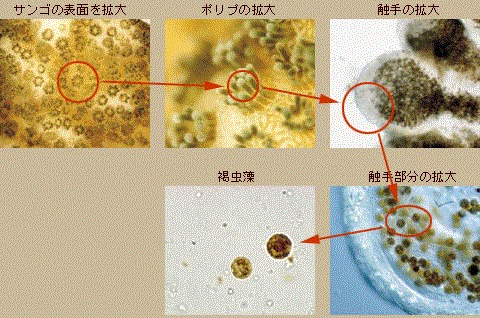 珊瑚礁を造る珊瑚、造礁珊瑚の表面は多数のポリプにおおわれています。ポリプには褐虫藻が共生していて珊瑚の成長を促進しています。褐虫藻が光合成によって作り出す有機物と酸素は珊瑚の成長を助け、珊瑚の排泄する窒素と二酸化炭素は褐虫藻の成長を助けているからです。造礁珊瑚は25度から29度の海水温の海域で生息していますが、海水温が30度を越すと死滅し、いわゆる珊瑚の白化が起こります。 〔国立科学博物館の『微小藻の世界』の『藻類のすみか』の『共生の藻』から〕 褐虫藻の大きさは10ミクロン(1/100ミリ)程度。表面積1平方センチあたり100~300万個も共生している。 |
| 参考 |
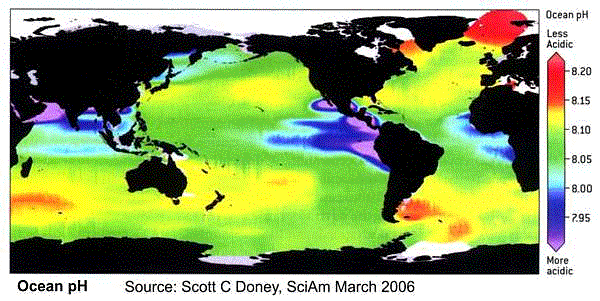 This world map of ocean acidity shows that ocean pH varies from about 7.90 to 8.20 but along the coast one may find much larger variations from 7.3 inside deep estuaries to 8.6 in productive coastal plankton blooms and 9.5 in tide pools. The map shows that pH is lowest in the most productive regions where upwellings occur. It is thought that the average acidity of the oceans decreased from 8.25 to 8.14 since the advent of fossil fuel (Jacobson M Z, 2005). 〔Anthoni,J.F.氏によるThe chemical composition of seawaterから〕 |
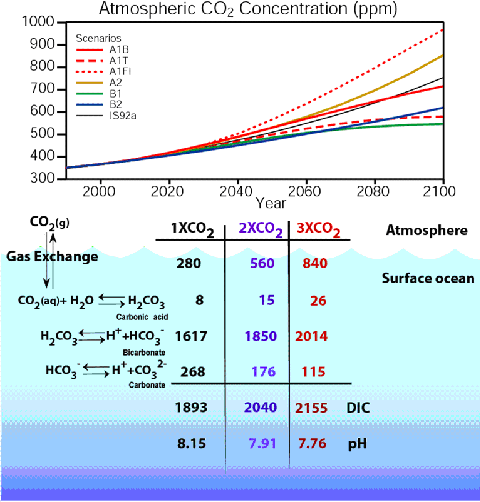 Summary of surface ocean carbon chemistry with rising atmospheric CO2 levels Air-sea gas exchange is a physico-chemical process, primarily controlled by the air-sea difference in gas concentrations and the exchange coefficient, which determines how quickly a molecule of gas can move across the ocean-atmosphere boundary. It takes about one year to equilibrate CO2 in the surface ocean with atmospheric CO2, so it is not unusual to observe large air-sea differences in CO2 concentrations. Most of the differences are caused by variability in the oceans due to biology and ocean circulation. The oceans contain a very large reservoir of carbon that can be exchanged with the atmosphere because the CO2 reacts with water to form carbonic acid and its dissociation products. As atmospheric CO2 increases in the future, the interaction with the surface ocean will change the chemistry of the seawater. The total dissolved inorganic carbon (DIC) content of the waters will increase. Because CO2 is an acid gas, the carbonate ion (CO32-) concentration and pH of the surface waters will decrease. The physiological effects of these changes on ocean biology are not fully understood, but studies have suggested that these changes may decrease calcification rates in coccoliths, corals, and coralline algae. 〔NOAAのPMEL CO2 Programから〕 現在の海水は pH 8.15 程度であるが、大気中二酸化炭素濃度が2倍になれば pH 7.91 に、3倍になれば pH 7.76 になると予想される。 |
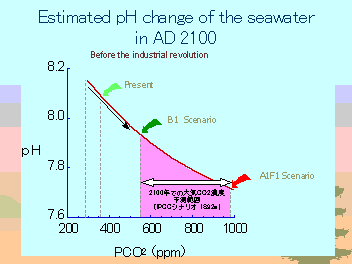 〔UNESCOのAn International Science Symposium(10-12 MAY 2004)でのYoshihisa Shirayama氏による『Biological impacts on marine organisms in a high-CO2 world (3 MB ppt)』から〕 |
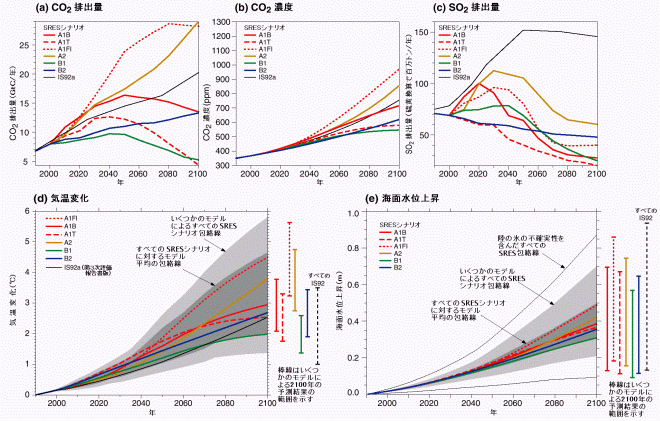 図SPM-5:21世紀の地球の気候は,自然の変化と気候システムの人間活動に対する応答で決まることになる。 [(a)は第3章図3.12,(b)は第3章図3.12,(c)は第5章図5.13,(d)は第9章図9.14,(e)は第11章図11.12,付録2に基づく] |
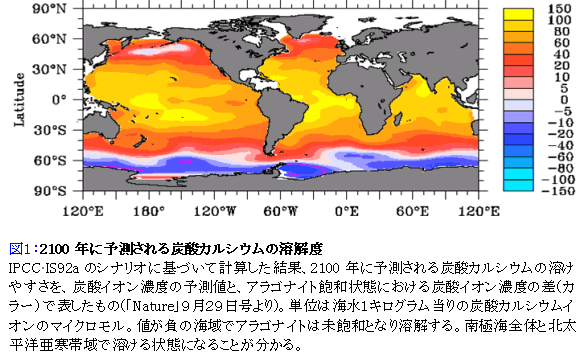 〔(独)海洋研究開発機構の地球環境フロンティア研究センターの中の『二酸化炭素濃度上昇がもたらす海洋酸性化による海洋の生物に迫る危険』から〕 ⇒Movie of this surface saturation state (with respect to aragonite) during the 21st century |